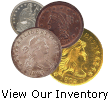For several different years, some proof Roosevelt Dimes from the San Francisco Mint were struck without the “S” mintmark. For each occurrence, the “No S” Proof Roosevelt Dimes are rare. In a few situations, the coins are significant rarities with only a handful known to exist.
The 1968 “No S” Proof Roosevelt Dime was the first situation. Responsibility for making proof dies rested with the Philadelphia Mint and production took place at the San Francisco Mint. At least one die was sent from Philadelphia lacking the “S” mint mark. A small number of dimes were struck with the die and released before the mistake was discovered. Approximately 12-14 examples are known in all grades. One of these, graded by PCGS as PR68 Cameo, sold for an astonishing $48,865 in September 2006.
Two years later in 1970, more proof Roosevelt Dimes were struck without a mint mark. This time production from an entire die pair was released before discovery, resulting in an approximate mintage of 2,200 of the 1970 “No S” Proof Roosevelt Dimes.
The 1975 “No S” Proof Roosevelt Dime emerged as the rarest of this error type. An extremely small number of proof coins missing the mint mark were released. The coins were so rare that they were not discovered until 1978 when two examples surfaced. These coins are now considered one of the major rarities of the 20th century with an estimated 2 to 5 pieces known. No examples have been graded by either PCGS or NGC.
One more time in 1983, proof dimes were minted without the “S” mint mark and released in some proof sets. The mintage is estimated at the life of a proof die, which at the time was 3,000 to 3,500 coins.
Psssst…we've got one if you’re interested…
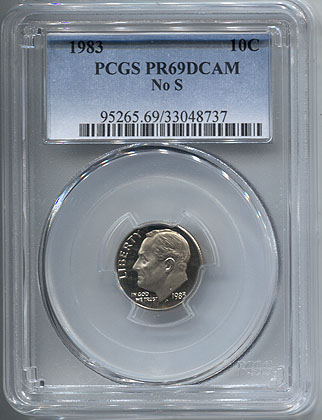
The following was written by Chris.
We attended the Whitman Coin Expo in Baltimore last week. This show is held three times a year and is the largest coin show on the East Coast. While the summer show is usually smaller and quieter, the spring and fall shows are typically quite active.
Our business in Baltimore began on Wednesday before the show. We, along with a handful of other dealers, always rent a hotel conference room to do some pre-show trading. Usually these days are busy non-stop from open to close. Unfortunately it was a bit slower than usual this time. Our trading room was somewhat hidden on the second floor of the Hilton. Many dealers we usually see on pre-show days simply didn’t find us. We’ll definitely get a better location next time.
The actual show opened at 8 am on Thursday. The typical mad rush ensued with people hustling to other folks’ tables in an attempt to get an early shot to look at inventory. The first couple of days at just about any coin show are busy from when the bourse floor opens to when it closes. The Whitman Expo was no different.
From a buying perspective, the show was a good one for me. I bought a little bit more than I normally do at this show and came home with about three double-row boxes of newps. I haven’t had an opportunity yet to see what new purchases Tom made, but he no doubt came home with at least two boxes of new purchases himself, and probably more.
Sales were perhaps a tad sluggish for us, but that’s primarily because we weren’t able to show all of our “regular” wholesale dealers that we normally like to see at these shows. They were in attendance but just too busy to look through all of our boxes. Two big coins were sold, however, which certainly helped boost our overall sales. Our Continental Dollar PCGS AU58 CAC and our $50 Pan-Pac Round both sold.
At least with the dealers I dealt with, there was somewhat of a positive vibe. Some encouraging words were said about the market which is something we typically haven’t heard for quite a while. We saw no further softening of prices in the types of coins we typically buy for inventory. It will be interesting to see how the Central States show later this month plays out.
Okay, the business side of this commentary is over. If you aren't already bored to tears, feel free to read on for some personal commentary...
Things I liked about the trip:
*The Light City Festival. This was going on the week of the show. It is apparently the first large-scale, international light festival in the United States. Much of the Inner Harbor area was covered in really neat light displays. Read more at http://lightcity.org. It was a cool thing to see.
*A Così restaurant opened directly across the street from the convention center. Very convenient for those wanting something other than the typical convention center fare. I enjoyed lunch there both Thursday and Friday and it’s sure to become my regular grab-and-go lunch spot for future shows in Baltimore.
*I found a new hangout for socializing in the evenings. I met up with a bunch of coin folks at Supano’s Steak House on Water Street on Thursday evening. The restaurant has a basement replete with several couches and lounge chairs, a small bar, a couple of dart boards, and most importantly a pool table. I held the table for close to two hours until getting my butt kicked by some local kid. With my tail between my legs, I left for the upstairs section to listen for a while to some coin dealers sing karaoke. I did not participate.
Things I didn’t like about the trip:
*The Light City Festival. One thing I usually enjoy during my trips to Baltimore is an evening at the movie theater. I simply do not have the time when I’m home to partake in a film. On Wednesday evening I set out for the movie theater which is usually a 10-12 minute walk from my hotel. Well, I was not expecting the mob of people who were attending the Light City Festival. The pedestrian bridges over the piers were clogged with people going to the different exhibits. It almost seemed like Bourbon Street during Mardi Gras. Nearly 25 minutes later I make it to the theater. For the first time ever I was late to a movie. I totally missed the previews!
*My flight home was horrible. The flight was delayed and I was sitting on the plane for 45 minutes before the captain bothered to come on and explain the reason for the delay (weather). We sat on the tarmac for another hour before we were finally able to take off. Once in the air, it was a roller coaster ride most of the way to Boston. I have no idea how the flight attendants stayed on their feet while serving drinks. It was so rough they announced that no hot beverages would be served for fear of passengers getting hot coffee spilled on them. But we finally landed safely and I was home about 2 ½ hours later than planned. Better late than never when it comes to flying.
Edited to add a few pictures Tom took while attending the Light City Festival:

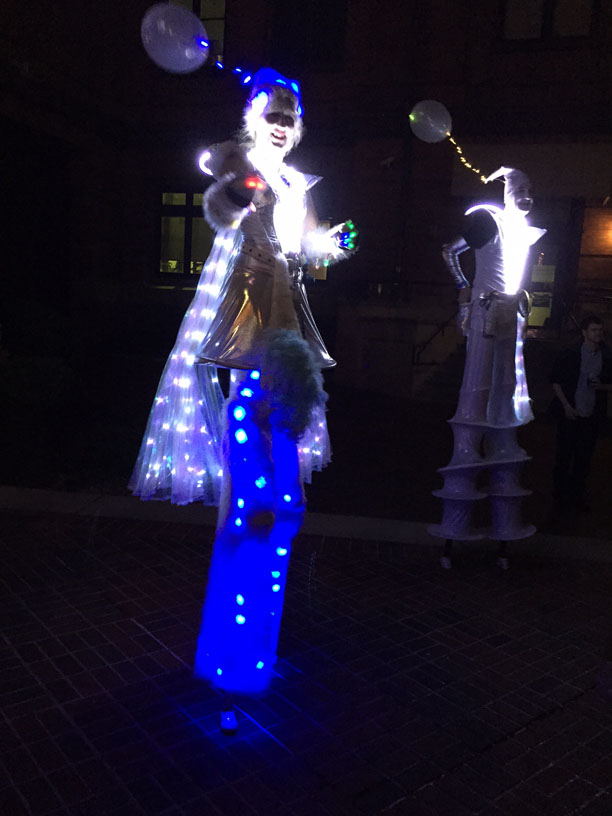
In one of the most exciting numismatic discoveries of this century, a 6th 1913 Liberty Head nickel has been found! A very old safe deposit box belonging to J.V. McDermott was opened last weekend in Dixon, Illinois.
In the same fashion as the McDermott specimen, B.G. Johnson and Eric P. Newman sold it to James Kelly, who then sold it to J.V. McDermott. McDermott was known for carrying his specimen around, showing it off at bars and boasting of its rarity – and now we know why; he had another ‘in his back pocket’, so to speak. There is no telling what the value of this 6th example will bring, but it is sure to bring over 1 million, depending on its condition of course.
Pictures to come once they have been made public.
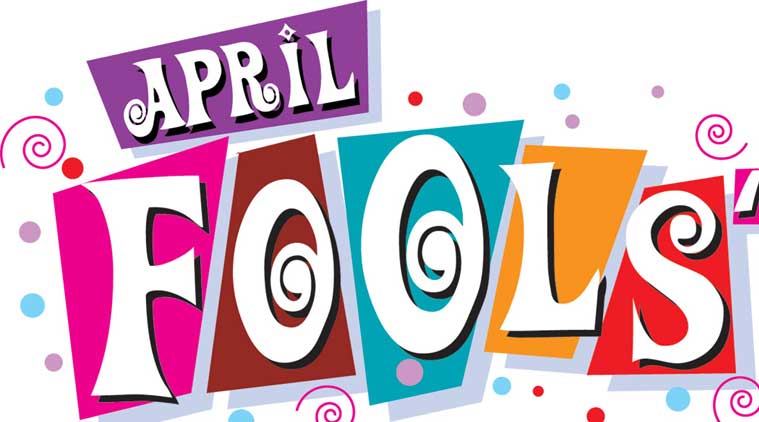
The topic of coin show etiquette comes up every now and then. Collectors sometimes wonder what the best way is to approach and interact with dealers at a coin show. Every dealer is likely to vary in the way they do business with the public at a coin show. Here’s what I have to say on the subject broken down by the type of interaction.
How to Approach a Dealer – Pretty much common sense should prevail here. If a dealer is clearly doing business with someone else, don’t interrupt and expect to be bumped in front of the other person. Patiently wait a little while, or check back later, or perhaps just scribble a note asking the dealer to call you when he or she is free and slide it over to them. Obviously include your name and number.
So, what about a dealer who is not interacting with another customer? As long as they see you there, they will come over. If they don’t, move on to the next table; they don’t deserve your business. On occasion I might be behind the table by myself and have my nose buried in an auction catalog working on bids or figuring a deal at our back table. If I (or any other dealer) don’t seem to be noticing you, just give me an “Excuse me?” or anything else to get my attention (short of throwing one of the pens we give away at my head). We’re there to do business, so please don’t walk away without giving us a chance.
Selling a Coin – Here’s where I’m sure many dealers will diverge on their preferences. If you are looking to sell a coin, then you should know the price for which you’re willing to sell it. If someone offers me a coin, I will ask them how much it is. I’m not a big fan of the response “Well, I don’t really know.” How can I possibly buy the coin from you if you don’t know what you’ll sell it for? Bottom line…come prepared.
Now, of course I understand you want to maximize the sale price of your coin. I’d prefer you to be honest and just say you’re looking for offers. I will usually make an offer if it’s something I’m particularly interested in. If I’m not, I may very well just ask you to come back with a firm price once you’ve received what you feel are enough offers. I can then simply pass or play.
Negotiating a Deal – We come to the coin shows with every intention of selling as many coins as we can. If you see something in our case or one of our many boxes that are of interest to you, please ask us for a price. If it’s a coin we’ve had in our inventory for a little while, we are almost always willing to work with you on the price.
I routinely get asked: “What’s your best price?” It’s an understandable question and I am happy to respond with my best price. If that price is too high, you can simply pass on the piece. No hard feelings! If the price is acceptable to you, we should have a deal! What I (and many other dealers) find annoying is continuing to hammer me for a better price when I’ve already quoted it. Perhaps some dealers like this little game, but I certainly don’t. Ask my best price too many times and I may very well raise it over what I initially quoted you.
Don’t Walk Behind a Dealer’s Table Without Permission – Self-explanatory.
Don’t Transact Business at a Dealer’s Table Without Permission – You shouldn’t expect to be able to take up the front of a dealer’s table so that you can transact business with someone other than that dealer. I know this sounds like common sense, but you’d be surprised at what some folks do at these shows. If someone just wants to quickly show you a coin, then ask the dealer if it’s okay to use their light for a moment. As long as I have a light not being used by someone else at that moment, then I’m always happy to oblige. But if it goes further than just looking at a coin, then you should find somewhere else to transact your business.
Kellogg & Company was one of the private minters that helped fill the need for coins in commerce in California when the United States Assay Office was being established. There are two designs that imitate the U.S. Liberty $20 gold coin. They have the date 1854 or 1855 and the legend SAN FRANCISCO CALIFORNIA TWENTY D. appears around an eagle with outstretched wings and a shield on its breast. Sun rays with stars are above the eagle’s head. Kellogg & Company dissolved in 1854 but was reestablished as Kellogg & Humbert at which time a $50 gold coin was produced.
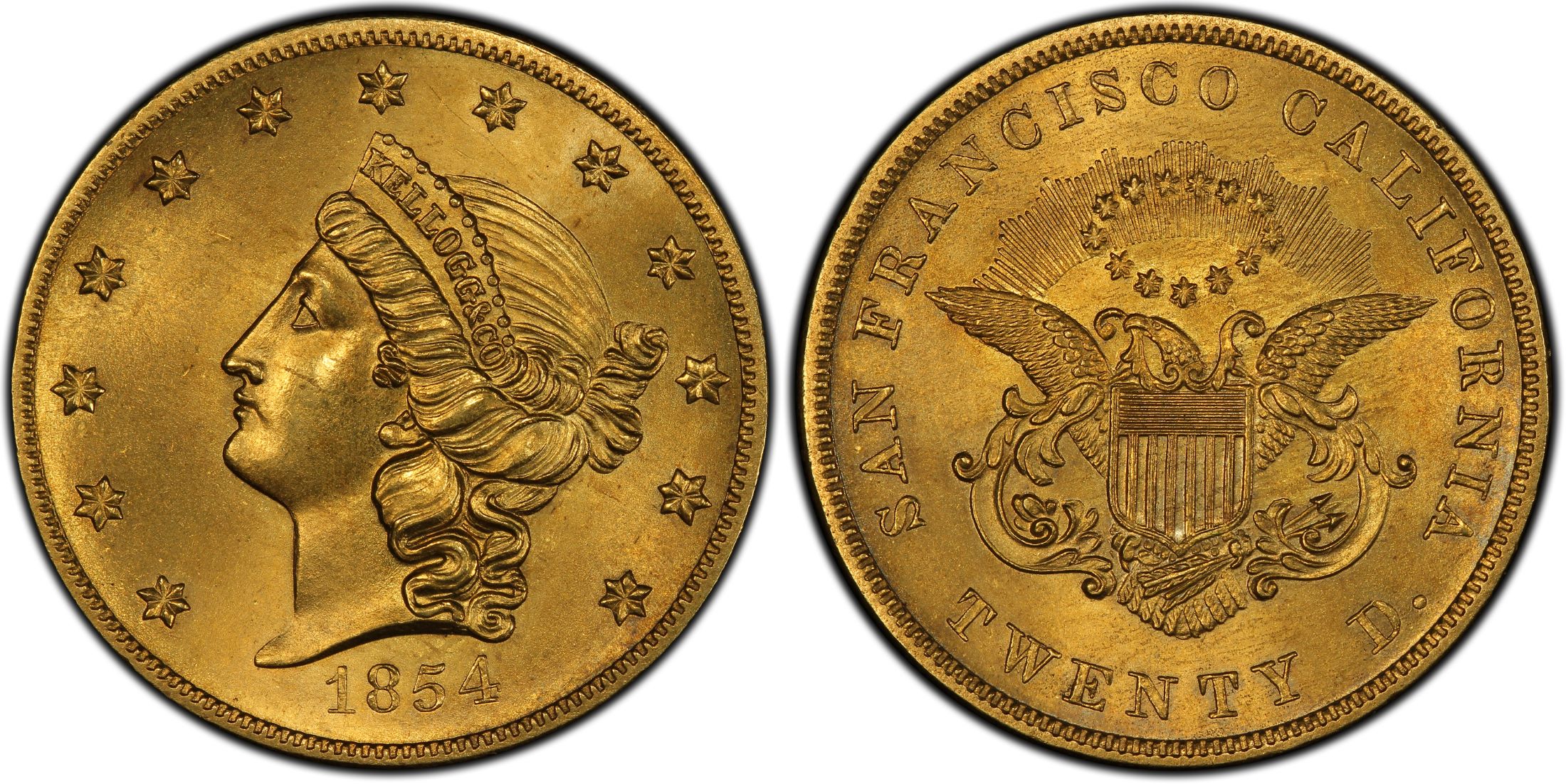
Not to be confused with Kellogg's cereal...




